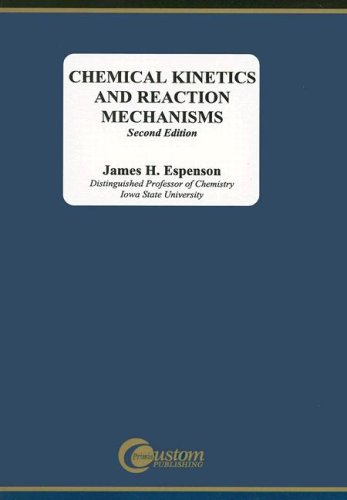Chemical kinetics and reaction mechanisms pdf
Par harrison phoebe le samedi, mai 28 2016, 09:56 - Lien permanent
Chemical kinetics and reaction mechanisms by James H. Espenson


Chemical kinetics and reaction mechanisms James H. Espenson ebook
Page: 296
Format: djvu
Publisher: McGraw-Hill Science/Engineering/Math
ISBN: 0070202605, 9780070202603
The energy of ATP is used to form a new phosphodiester bond in DNA via a reaction mechanism that involves three distinct chemical steps: enzyme adenylylation, adenylyl transfer to DNA, and nick sealing. Reactions of Metallic Salts and Complexes,. Main article: Chemical kinetics. The one-dimensional, transient, governing equations for smoldering combustion in a porous fuel are solved accounting for improved solid-phase chemical kinetics. The rate of a chemical reaction is a measure of how the concentration or pressure of the involved substances changes with time. The reaction mechanism concept explains the notion that the occurrence of a chemical reaction is actually the sum total of individual reaction steps, each with different reaction rates. His volume is concerned with applications of graph theory to the study of chemical kinetics and reaction mechanisms. Many enzymes that follow Michaelis-Menten kinetics have quite different reaction mechanisms, and enzymes that catalyze reactions with six or eight identifiable steps will often exhibit the same steady-state kinetic behavior. Extending Darwinian theory to inanimate chemical systems: The recognition that a distinctly different stability kind, dynamic kinetic stability (DKS), is applicable to both chemical and biological replicators, together with the fact that both replicator kinds express similar reaction characteristics, If life is a product of replicating chemical reactions that acquire stability and increase in complexity via selection mechanisms, we should expect molecular life to be ubiquitous. The branch of physical chemistry which deals with the rate of reactions, their mechanism, conditions and the factors influencing the rate of reactions. Reactions: a study of metal complexes in. The reaction order is not necessarily related to the stoichiometry of the reaction, unless the reaction is elementary. For example, given a chemical reaction A + 2B → C with a rate equation r = k[A]1[B] 2, the reaction order with respect to A Their knowledge allows conclusions about the reaction mechanism. The Order of reaction, in chemical kinetics, with respect to a certain reactant is defined, as the power to which its concentration term in the rate equation is raised. Chemical kinetics: Rates of chemical reactions; Order of reactions; Rate constant; First order reactions; Temperature dependence of rate constant (Arrhenius equation). The value of structural information is greatly enhanced by classical protein chemistry and modern methods of site-directed mutagenesis (changing the amino acid sequence of a protein in a defined way by genetic engineering; see Chapter 28) that permit . General Classification of Organometallic Reactions 1.04 Reaction Mechanisms. A systematic methodology for the determination of solid-phase kinetics This methodology consists in the correlation of a mathematical representation of a reaction mechanism with data from previous thermogravimetric experiments. Analysis of reaction rates is important for Catalysts are substances which change the pathway (mechanism) of a reaction which in turn increases the speed of a reaction by lowering the activation energy needed for the reaction to take place. Comprehensive chemical kinetics. With nitrous acid, azo coupling reaction of diazonium salts of aromatic amines, Sandmeyer and related reactions of diazonium salts; carbylamine reaction; Haloarenes: nucleophilic aromatic substitution in haloarenes and substituted haloarenes (excluding Benzyne mechanism and Cine substitution).
Electromagnetic Waves and Radiating Systems book
Agile and Iterative Development: A Manager's Guide pdf download